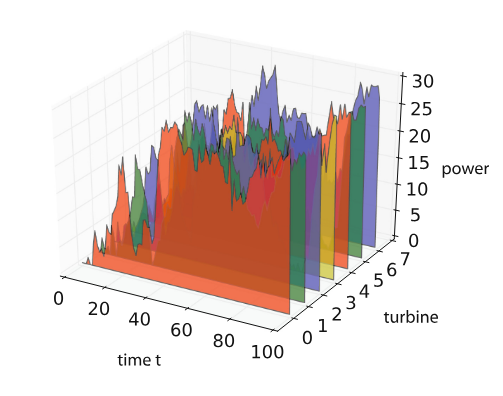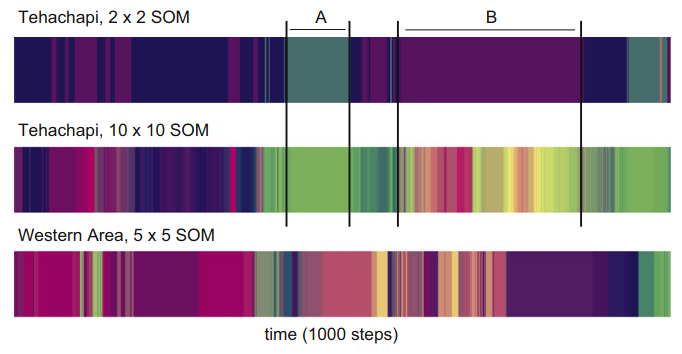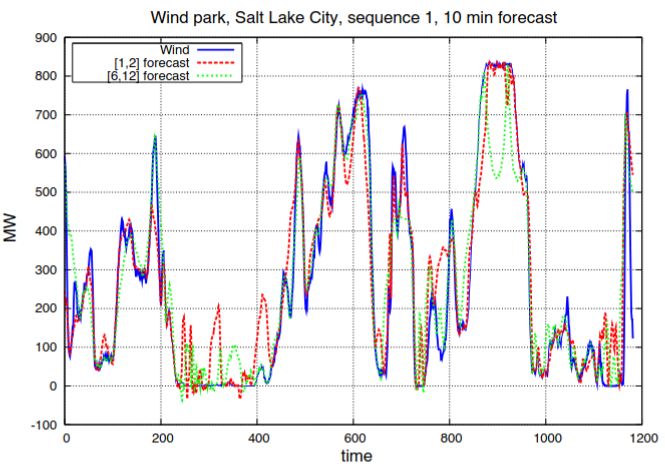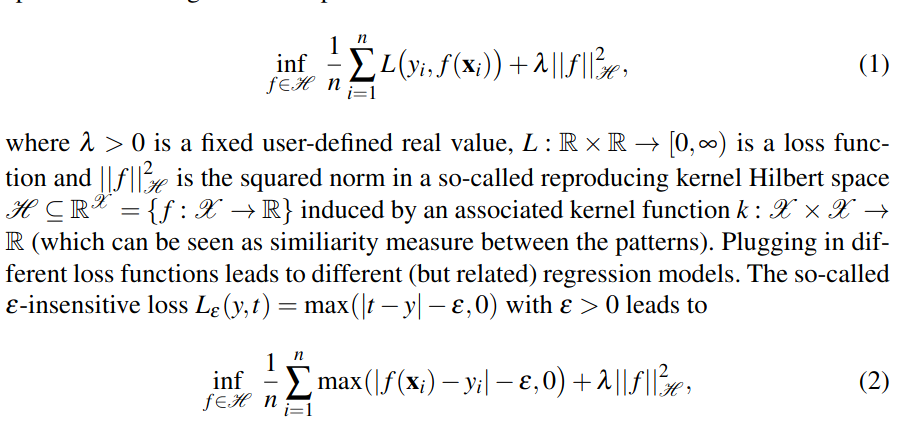Publications tagged "energy"
- O. Kramer, F. Gieseke, J. Heinermann, J. Poloczek, and N. A. TreiberData Analytics for Renewable Energy Integration - Second ECML PKDD Workshop, DARE 2014, Nancy, France, September 19, 2014, Revised Selected Papers 2014
Wind energy is playing an increasingly important part for ecologically friendly power supply. The fast growing infrastructure of wind turbines can be seen as large sensor system that screens the wind energy at a high temporal and spatial resolution. The resulting data- bases consist of huge amounts of wind energy time series data that can be used for prediction, controlling, and planning purposes. In this work, we describe WindML, a Python-based framework for wind energy related machine learning approaches. The main objective of WindML is the continuous development of tools that address important challenges induced by the growing wind energy information infrastructures. Various examples that demonstrate typical use cases are introduced and related research questions are discussed. The different modules of WindML reach from standard machine learning algorithms to advanced techniques for handling missing data and monitoring high-dimensional time series.
@inproceedings{KramerGHPT14, author = {Kramer, Oliver and Gieseke, Fabian and Heinermann, Justin and Poloczek, Jendrik and Treiber, Nils Andr{\'{e}}}, editor = {Woon, Wei Lee and Aung, Zeyar and Madnick, Stuart E.}, title = {A Framework for Data Mining in Wind Power Time Series}, booktitle = {Data Analytics for Renewable Energy Integration - Second {ECML} {PKDD} Workshop, {DARE} 2014, Nancy, France, September 19, 2014, Revised Selected Papers}, series = {Lecture Notes in Computer Science}, volume = {8817}, pages = {97--107}, publisher = {Springer}, year = {2014}, doi = {10.1007/978-3-319-13290-7\_8}, tags = {application,energy}, } - O. Kramer, F. Gieseke, and B. SatzgerNeurocomputing 2013
Wind energy has an important part to play as renewable energy resource in a sustainable world. For a reliable integration of wind energy high-dimensional wind time-series have to be analyzed. Fault analysis and prediction are an important aspect in this context. The objective of this work is to show how methods from neural computation can serve as forecasting and monitoring techniques, contribut- ing to a successful integration of wind into sustainable and smart energy grids. We will employ support vector regression as prediction method for wind energy time-series. Furthermore, we will use dimension reduction techniques like self-organizing maps for monitoring of high-dimensional wind time-series. The methods are briefly introduced, related work is presented, and experimental case studies are exemplarily described. The experimental parts are based on real wind energy time-series data from the National Renewable Energy Laboratory (NREL) western wind resource data set
@article{KramerGS13, author = {Kramer, Oliver and Gieseke, Fabian and Satzger, Benjamin}, title = {Wind energy prediction and monitoring with neural computation}, journal = {Neurocomputing}, volume = {109}, pages = {84--93}, year = {2013}, doi = {10.1016/j.neucom.2012.07.029}, tags = {energy,application}, } - O. Kramer, and F. GiesekeSeventh International Conference on Natural Computation, ICNC 2011, Shanghai, China, 26-28 July, 2011 2011
Wind energy has an important part to play as renewable energy resource in a sustainable world. For a reliable integration of wind energy the volatile nature of wind has to be understood. This article shows how kernel methods and neural networks can serve as modeling, forecasting and monitoring techniques, and, how they contribute to a successful integration of wind into smart energy grids. First, we will employ kernel density estimation for modeling of wind data. Kernel density estimation allows a statistically sound modeling of time series data. The corresponding experiments are based on real data of wind energy time series from the NREL western wind resource dataset. Second, we will show how prediction of wind energy can be accomplished with the help of support vector regression. Last, we will use self-organizing feature maps to map high-dimensional wind time series to colored sequences that can be used for error detection.
@inproceedings{KramerG11, author = {Kramer, Oliver and Gieseke, Fabian}, editor = {Ding, Yongsheng and Wang, Haiying and Xiong, Ning and Hao, Kuangrong and Wang, Lipo}, title = {Analysis of wind energy time series with kernel methods and neural networks}, booktitle = {Seventh International Conference on Natural Computation, {ICNC} 2011, Shanghai, China, 26-28 July, 2011}, pages = {2381--2385}, publisher = {{IEEE}}, year = {2011}, doi = {10.1109/ICNC.2011.6022597}, tags = {application,energy} } - O. Kramer, and F. GiesekeSoft Computing Models in Industrial and Environmental Applications, 6th International Conference SOCO 2011, 6-8 April, 2011, Salamanca, Spain 2011
Wind energy prediction has an important part to play in a smart energy grid for load balancing and capacity planning. In this paper we explore, if wind measurements based on the existing infrastructure of windmills in neighbored wind parks can be learned with a soft computing approach for wind energy prediction in the ten-minute to six-hour range. For this sake we employ Support Vector Regression (SVR) for time series forecasting, and run experimental analyses on real-world wind data from the NREL western wind resource dataset. In the experimental part of the paper we concentrate on loss function parameterization of SVR. We try to answer how far ahead a reliable wind forecast is possible, and how much information from the past is necessary.We demonstrate the capabilities of SVR-based wind energy forecast on the micro-scale level of one wind grid point, and on the larger scale of a whole wind park.
@inproceedings{Kramer2011a, author = {Kramer, Oliver and Gieseke, Fabian}, title = {Short-Term Wind Energy Forecasting Using Support Vector Regression}, booktitle = {Soft Computing Models in Industrial and Environmental Applications, 6th International Conference {SOCO} 2011, 6-8 April, 2011, Salamanca, Spain}, year = {2011}, editor = {Corchado, Emilio and Sn{\'{a}}sel, V{\'{a}}clav and Sedano, Javier and Hassanien, Aboul Ella and Calvo{-}Rolle, Jos{\'{e}} Lu{\'{\i}}s and Slezak, Dominik}, volume = {87}, series = {Advances in Intelligent and Soft Computing}, pages = {271--280}, publisher = {Springer}, doi = {10.1007/978-3-642-19644-7\_29}, tags = {application,energy}, }



